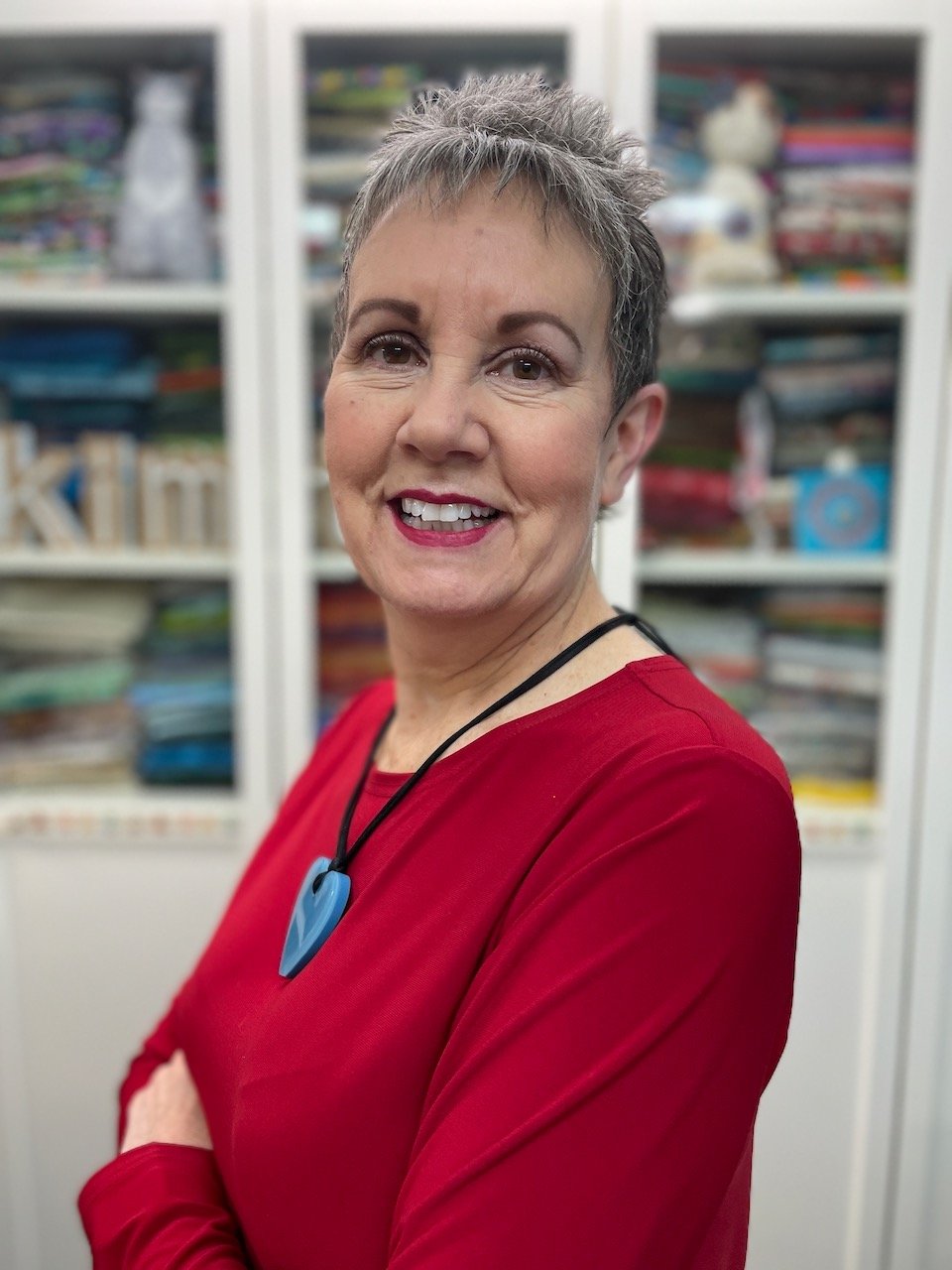
CHATTERBOX QUILTS’ BLOG
Helping Quilters Learn and Improve
Alex in the Long Arm Studio
Now that I have a new long arm machine I also have more accessories that need to be stored in my quilt studio, or should I say long arm studio, situated in the quilt studio annex - commonly called the basement.
Surprisingly I haven't gone hog wild and bought every long arm accessory on the market. I did get a ruler base and one ruler: Handi Quilter's VersaTool. I bought extra bobbins and needles and the channel locks too. To save my fingers I bought some Leader Grips and love working with these - so much quicker and pain free! I think I have enough tools for now, but I do need to store them somewhere convenient so I can access them when long arming. Where could I find a storage unit for them? Ikea, of course!
Photo courtesy of handiquilter.com
I already have one Alex in which I store my threads, now I could get the wider, lower one to fit under my Handi Quilter Infinity. A quick jaunt to Ikea - really, I didn't look at anything else and went straight to the aisle to get it - and home I came with a new long arm accessory storage unit.
Photo courtesy of ikea.com
Thanks to hubby, it was quickly assembled and now I have all I need to long arm, including my pantographs, easily accessible under my Infinity.
Gotta love Ikea for their practical pieces and great price point.
Have you Ikea'd your studio yet? Leave a comment below letting me know what Ikea pieces you have in your studio.
Creatively,
Telecast Thursday - Bohin Double Needle Threader Review
Do you have problems threading small eyed needles?
I like to use size 10 sharps when hand stitching on my binding and struggle to get the thread through the small eye on this size needle.
I've been using the Clover Double Needle Threader and it works okay, but I find that the metal part that you use to thread the needle becomes distorted over time and eventually breaks, so I have to buy a new one.
I also need to have my reading glasses on to use this product - so I can get the thread into the metal part - but I've found a wonderful alternative that I'm loving: the Bohin Double Needle Threader.
This product threads my needles easily and best of all I don't need my reading glasses to use it!
Watch the video below or on my Youtube channel to see how easy it is to use the Bohin Double Needle Threader.
If you're having trouble threading your small eyed needles, give the Bohin Double Needle Threader a try - you'll find it a snap!
Creatively,
P.S. I'm an Amazon affiliate and will receive a small compensation if you purchase an item using the links in this blogpost. This helps me continue to provide you with videos and tutorials. Thanks!
Easy Felted Soap Project
If you're looking for an easy beginner felting project and you don't mind getting wet, I have just the one for you!
I have a large bag of multiple colours of wool roving (just couldn't resist all the yummy colours!) and was looking for a quick and easy felting project. I found one in the Quilting Arts June/July 2015 edition. Jane LaFazio has an article on felting soap and it's perfect for beginner felters. This is a wet felting project so be prepared to get lathered up – in a good way!
You don't need much for this project:
2 - 3 colours of wool roving
Small bar of soap (I used one of those soaps you get from hotels)
Hot water
Patience - this process takes about 20 minutes
Felting materials
An extra pair of hands doesn't hurt either in case yours get tired.
To start, choose some wool roving – I chose two different colours, but you could use more colours than that. You don't need much: just tear off about a two inch swatch of it and place it over the soap. Don't cut your roving – it should tear easily. If you need some help in choosing colours, enlist your purry assistant for some advice.
Charlie is thrilled with these colour selections
Layer the roving over the soap and then turn it to the other side of the soap and add more roving.
First piece of wool roving applied to one side of the soap
Keep adding layers of wool roving, alternating the colours of wool roving and the direction so you have a sort of weave of wool roving across the soap on both sides. Four layers of wool roving should be enough.
Layers of wool roving ready for felting
Next, you'll need that hot water. I did this in my kitchen sink. Get the soap and roving thoroughly wet in hot water, being careful not to disturb the layers of wool.
Getting the roving completely saturated is the first wet step
Once it is completed saturated, squeeze out the excess water. This helps to stick the wool roving to the soap. Once it feels – yes, this is a touchy feely project – that the wool is stuck to the soap and the felting has begun, you can start creating that lather. Rub the bar back and forth in your hands – just like you do when washing your hands. This will start the felting process.
Wool roving is completely wet and ready to start the lathering process
After about five minutes of lathering, rewet the bar under the hot water. Don't be concerned about the large amount of lather this process creates – there will still be soap inside the wool roving.
First round of lathering - are my hands clean yet?
Continue rubbing the bar on all sides for another five minutes and then rewet the bar in the hot water. You may have to repeat this rubbing and rewetting sequence this one or two more times.
Round two or three - time for another pair of younger hands to take over
Once the wool roving is firmly bound to the soap (completely felted), rinse the soap in cold water and set it aside to dry. This may take some time, so you now have the opportunity to do some quilting or get a chocolate snack.
Final cold rinse and it's done!
Now you've got a pretty scented gift to give a friend or to display in a lovely container along with the other bars that I'm sure you'll be making for yourself. Make several at one time so you'll always have a scented gift on hand.
Try this quick felting project yourself and let me know how it went in the comments below.
Creatively,
Singer 128 with La Vencedora Decals
I almost forgot to tell you about my other machine acquisition: a Singer 128 with La Vencedora decals. While I already have a Singer 128, I was drawn to this machine due to its beautiful intricate decals. I've seen other models of this machine before in other venues, but never have I seen one in such good condition and at such a great price!
While I already have a Singer 128, I was drawn to this machine due to its beautiful intricate decals. I've seen other models of this machine before in other venues, but never have I seen one in such good condition and at such a great price!
This machine reminds me of my Singer 66 Red Eye, but it is a bit different. First, the Singer 128 is smaller than the Singer 66 – something you instantly notice when you see both machines together. The Singer 128 is about ¾ the size of the Singer 66 model.
Can you tell the difference? The Singer 128 with the La Vencedora decals in in front of the Singer 66 Redeye model
The decals are also similar: they're both intricate and in gold, red and green colours, but on closer inspection you can definitely see the difference.
Although the decals on my Singer 66 Redeye model aren't in the best shape, this gives you an idea of what they look like.
My Singer 66 has a drop-in bobbin, whereas the Singer 128 is a long bobbin or shuttle machine. The Red Eye model is non-electric and is in a treadle stand. The new (to me) Singer 128 is an electric model and is in a wooden base. So really these machines aren't that alike – other than they are both made by Singer and look gorgeous!
I haven't yet had time to clean the Singer 128, but am looking forward to seeing how this machine shines with a little TLC.
To see more of my latest vintage sewing machine, watch the video below.
Creatively,
My Favourite Craftsy Machine Quilting Classes
As you know I have a new toy in the studio. Yes, I finally have a long-arm quilting machine. Yay! I've been wanting (lusting for) a long-arm machine for years now and I finally bought one. I purchased a Handi Quilter Infinity. It has a 26" inch throat, which translates into about 20" of quilting space. Now I have no excuse for not finishing those quilt tops that have been languishing in bags and boxes in my studio.
Photo courtesy of handiquilter.com
While I don't make New Year's resolutions, 2016 will be the year to learn how to quilt on my new long-arm machine.
I'm itching to use this machine and to help me out, I'm watching Craftsy classes that I've purchased. I knew that the day would come when I could put this knowledge to use on my own long-arm quilting machine. Some of these classes are done on a domestic sewing machine, but the designs translate well for use on a long-arm quilting machine too.
Here are some of my favourite Craftsy classes that I'm sure will be a big help in my long-arm quilting adventure:
A New Look at Long-Arm Quilting with Mandy Leins - In this FREE class, Mandy explains some of the essentials of long-arm quilting and gives you some simple designs to help you gain confidence for the new long-arm quilter. I like the information that she provides regarding user comfort when working on a long-arm machine.
Machine Quilting Negative Space with Angela Walters – Angela shows you lots of free motion designs on a long-arm quilting machine. She also explains how to combine the various designs and alter their sizes to create interest.
Free-Motion Quilting with Feathers with Angela Walters – Working on a domestic sewing machine, Angela shows you how to create interesting feather motifs. She also shows you how to insert these designs in borders and blocks. Angela makes it easy to create unique feathers motifs in your quilts.
Divide & Conquer: Creative Quilting for Any Space with Lori Kennedy – I've followed Lori's blog for years and was thrilled when I saw she had a Craftsy class. As in her blogposts, Lori shows you a variety of motifs that can be adapted to the desired place on your quilt. Orange Peel, ribbons, leaves, flowers, sailboats and more, you'll learn how to create all these designs and many more. This is a great class if you're looking for motifs to add to your quilt designs.
Free Motion Fillers, Vol. 1 with Leah Day
Free Motion Fillers, Vol. 2 with Leah Day
I'm sure you've heard of Leah Day's Free Motion Quilting Project where she created a new quilting design each day for a year (and continues to add new designs). In these two classes Leah shares some of these designs and has lots of helpful tips and information about machine quilting. Using her domestic machine (the same Janome I currently own), Leah walks you through each motif describing how to create these designs successfully.
Machine Quilting Wholecloth Quilts with Cindy Needham
Design it, Quilt it: Free-Form Techniques with Cindy Needham
Cindy Needham creates amazing wholecloth quilts and quilts using vintage linens – something I love to collect. Both of these classes show you Cindy's approach to quilting on her domestic machine and include many quilting motifs. Cindy uses stencils as well as free-motion designs to create her amazing works of art. If you're an intermediate to advanced quilter, you'll learn to create beautiful art pieces in these classes.
This may seem like a lot of classes, but I find different and helpful information in each one of them. I like to take multiple classes from the same instructor – it almost feels like they're a friend helping me with my quilting.
If you're looking for classes to help you in your quilting adventure, I highly recommend any of these Craftsy classes. Enrol and start learning today!
Creatively,
P.S. I am a Craftsy affiliate and will receive compensation if you purchase through any of the links in this blogpost. This helps me to continue creating video and tutorial content for you. Thanks :)
Welcome! I’m Kim Jamieson-Hirst of Chatterbox Quilts, a YouTube creator and host of The Quilter’s Way. I believe that quilting is more than just a 1/4” seam and that practice makes improvement and you are improving every day!
Contact me at kjh@chatterboxquilts.com.
Want to improve your quilting and have fun doing it? Join The Quilter's Way, a private online membership site that creates successful quilters.
As an Amazon Associate I earn from qualifying purchases from links that you may find on the Chatterbox Quilts’ website.

































